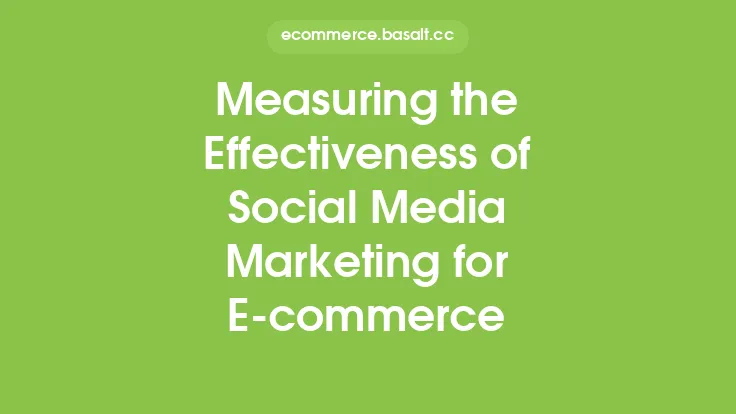The rise of social media has revolutionized the way businesses interact with their customers, and one of the most significant impacts has been on the world of e-commerce. Social commerce, which refers to the use of social media platforms to facilitate online sales, has become a crucial aspect of any e-commerce strategy. In this article, we will explore the evolution of social commerce, its current state, and how businesses can leverage social media to drive sales and growth.
Introduction to Social Commerce
Social commerce is a subset of e-commerce that involves using social media platforms to promote and sell products or services. It has become an essential channel for businesses to reach their target audience, build brand awareness, and drive sales. Social commerce has evolved significantly over the years, from simple social media advertising to more sophisticated strategies that involve influencer marketing, user-generated content, and social media-based customer service.
History of Social Commerce
The concept of social commerce dates back to the early 2000s, when social media platforms like Facebook and MySpace started gaining popularity. Initially, businesses used these platforms to build brand awareness and engage with their customers. However, as social media evolved, businesses began to explore ways to use these platforms to drive sales. One of the earliest examples of social commerce was the use of Facebook's "Shop" tab, which allowed businesses to create a virtual storefront on their Facebook page. Since then, social commerce has grown exponentially, with the rise of new social media platforms like Instagram, TikTok, and Pinterest.
Benefits of Social Commerce
Social commerce offers several benefits to businesses, including increased brand awareness, improved customer engagement, and enhanced sales. Social media platforms provide businesses with a vast audience, and by leveraging these platforms, businesses can reach their target audience more effectively. Social commerce also allows businesses to build a community around their brand, which can lead to increased customer loyalty and retention. Additionally, social media platforms provide businesses with valuable insights into their customers' behavior and preferences, which can be used to inform marketing and sales strategies.
Social Media Platforms for Social Commerce
Several social media platforms are well-suited for social commerce, including Facebook, Instagram, TikTok, and Pinterest. Each platform has its unique features and audience, and businesses should choose the platforms that best align with their target audience and marketing goals. For example, Instagram is a visual platform that is ideal for businesses that sell products with strong visual appeal, such as fashion and beauty products. TikTok, on the other hand, is a platform that is popular with younger audiences and is ideal for businesses that want to create short-form, engaging content.
Strategies for Social Commerce
There are several strategies that businesses can use to leverage social media for sales, including influencer marketing, user-generated content, social media advertising, and social media-based customer service. Influencer marketing involves partnering with social media influencers who have a large following in the target audience. User-generated content involves encouraging customers to share photos or videos of themselves using the business's products or services. Social media advertising involves using paid social media ads to reach a wider audience, and social media-based customer service involves using social media platforms to provide customer support and resolve customer complaints.
Measuring the Success of Social Commerce
Measuring the success of social commerce involves tracking several key metrics, including website traffic, sales, customer engagement, and return on investment (ROI). Businesses can use social media analytics tools to track these metrics and adjust their social commerce strategy accordingly. Additionally, businesses should also track their customer acquisition cost (CAC) and customer lifetime value (CLV) to ensure that their social commerce strategy is profitable.
Challenges and Limitations of Social Commerce
While social commerce offers several benefits, it also has several challenges and limitations. One of the biggest challenges is the ever-changing nature of social media algorithms, which can affect the visibility of business content. Additionally, social commerce requires a significant amount of resources and effort to create and curate content, engage with customers, and provide customer support. Businesses should also be aware of the potential risks of social commerce, including the risk of negative reviews and feedback, and the risk of intellectual property theft.
Future of Social Commerce
The future of social commerce is exciting and rapidly evolving. One of the biggest trends is the rise of social media-based marketplaces, which allow businesses to sell products directly on social media platforms. Another trend is the use of artificial intelligence (AI) and machine learning (ML) to personalize the social commerce experience and improve customer engagement. Additionally, the growth of augmented reality (AR) and virtual reality (VR) technologies is expected to revolutionize the social commerce experience, allowing customers to interact with products in a more immersive and engaging way.
Best Practices for Social Commerce
To succeed in social commerce, businesses should follow several best practices, including creating high-quality content, engaging with customers, and providing excellent customer service. Businesses should also be authentic and transparent in their social media interactions, and should prioritize building a community around their brand. Additionally, businesses should stay up-to-date with the latest social media trends and algorithm changes, and should be willing to experiment and try new things. By following these best practices, businesses can leverage social media to drive sales, growth, and customer engagement.





